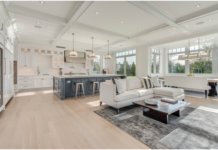LED lighting systems have become increasingly popular in kitchens in recent years due to their many benefits. From being energy-efficient to their long lifespan and dimmability, LED lights provide style, versatility, and functionality in one small package. Many LED lighting systems are also compatible with smart home technology, allowing homeowners to gain greater control over lighting levels while at home and even remotely. If you are planning on renovating your kitchen, LED lights are an elegant, environmentally friendly, and practical upgrade.
Considerations for your kitchen lighting
When people think about equipping their kitchen spaces, they mostly think about the kind of equipment they would put on countertops and the stoves they want to purchase. However, lighting can make a huge difference and transform your kitchen from a fresh and clean place to a setting with ambiance.
You should first consider the design of your kitchen. Do you want a bright and airy kitchen to make food prep and cleanup easier? Or perhaps you want the dimming capabilities in your lights to create a cosy atmosphere. Once you visualise how you want your kitchen to look, you can start selecting the right LED lights to install.
Choosing the right LED components
There is an array of LED components you can choose when it comes to equipping your kitchen with the right lights. Below, we go through each type, and how they fit in with your planning.
COB LEDs
COB stands for Chip on Board, and COB LEDs consist of a cluster of LED chips mounted directly onto a circuit board. The LED chips are packed closely together as they are small, and they are covered with a phosphor coating that converts the blue light emitted by the chips into a range of colours, including white and yellow light.
Most kitchen installations use COB LEDs as they are energy-efficient and can produce a high level of brightness from a small source. They are also versatile in design. Mounted on a circuit board, they can be arranged in different configurations and integrated into existing systems. The LED lights can also emit different colours and colour temperatures.
LED arrays
Another option you have is an LED array. This is a collection of multiple LEDs arranged in a grid or pattern, and the outcome is that you have a more focused light output. This output can be dim and create ambiance in the kitchen, or it can be strong and create a striking spotlight effect.
LED array mounts
To properly install an LED array and secure it, you will need an LED array mount. This is a structure or platform that holds the LED arrays in a specific orientation and configuration. LED array mounts can be made from plastic, metals, and ceramic, depending on how you want your kitchen to look. They also allow LED arrays to be easily replaced when required.
LED strip lights
LED strip lights are flexible strips of LED lights that can be used with or instead of LED arrays. These strip lights consist of a flexible printed circuit board with a series of closely placed LED chips mounted along the length of the strip. If you want to line the edges of your countertops or prefer horizontal pendant lamps, LED strip lights can be a great source of lighting.
LED strip lights are adjustable in length, as they can be cut to length. They are also available in a wide range of colours and colour temperatures, and they can be dimmed and brightened. This makes them a great choice for accent lighting as well as other decorative applications.
LED holders
For those who prefer to work with LED bulbs instead of chips mounted on a circuit board, they can use LED holders to secure and mount the bulbs in place. Installation is relatively easy and simple, and replacement of the bulbs can be done quickly without replacing the entire structure. LED holders can be made from plastic, metal, or ceramic, and you can find a holder that fits the aesthetic of your home.
LED holders may also come with components such as clips and screws. Some also have adhesive backing to secure the light in place on walls. Those who want to create accent lighting and spotlight effects can do so with LED bulbs and holders – they simply need to purchase lenses, reflectors, and diffusers to control the direction and spread of the LED light source.
Putting it all together – building an LED system
Aside from the LED bulbs, chips, and holders, it is essential for those building an LED lighting system in their kitchen to use connectors to hold it all together. Some connectors include LED driver ICs and LED cables, which also take voltage of power supplies into consideration to ensure reliability and strong performance of your lights.
LED driver ICs
LED driver ICs (Integrated Circuits) are electronic components that regulate the power supply to LED lighting systems. LED driver ICs are vital as they convert AC or DC power to a constant DC power supply that is suitable for your LED lights, which require a specific voltage to operate correctly.
LED cables
LED cables are electrical cables that help you connect your lighting components such as your LED strips, bulbs, and drivers. These cables transmit power and data – or both, for smart homes – and they come in multiple designs to cover different needs.
Final words
Upgrading your kitchen with an LED lighting system is a great way to enhance the look and feel of your home while creating a productive and energy-efficient environment. As more and more people turn to LED lights, it has also become more accessible for those who want to set up their own lighting system and renovate their homes at a lower cost. Knowing the different LED components available is a vital first step in redesigning your kitchen, and this knowledge can ensure you upgrade your home properly.
Must Read: 7 Advantages and Benefits of LED Lighting



































































